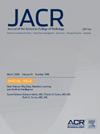Assessing Radiology Utilization in an Academic Center Partnership With a Federally Qualified Health Center Using A Cross-Sectional Study
IF 5.1
3区 医学
Q1 RADIOLOGY, NUCLEAR MEDICINE & MEDICAL IMAGING
引用次数: 0
Abstract
Objective
Federally qualified health centers (FQHCs) serve medically underserved populations. In 2013, UW Health, the health system of the University of Wisconsin, partnered with Access Community Health Centers (ACHC), the FQHC network in Madison, Wisconsin, to provide on-site outpatient imaging. This study characterized radiography utilization associated with the UW Health-ACHC partnership compared with other UW Health outpatient imaging sites.
Methods
We included health record data from January 2013 to December 2022 on all outpatient radiographs completed at UW Health sites. We compared characteristics between patients ever seen at ACHC clinics with patients seen only at non-ACHC UW Health clinics using χ2 and t tests. Logistic regression was used to assess factors associated with imaging utilization at ACHC.
Results
Over the study period, 4% (23,794 of 650,685) of imaging encounters occurred at ACHC and 4% (10,986 of 246,104) of patients used ACHC facilities at least once. ACHC clinic patients were younger (41 versus 42) and more often female (55% versus 53%), Black or African American (22% versus 5%), Hispanic or Latino (34% versus 4%), with Medicaid (33% versus 9%), uninsured (18% versus 4%), and living in metropolitan areas (98% versus 88%) with higher Social Deprivation Index scores (53 versus 31) (P < .001). In multivariable analyses, patients from racial or ethnic minority groups, without commercial insurance, residing in a metropolitan area, and with a non-English primary language were more likely to ever use ACHC radiography services (P < .001).
Discussion
FQHCs represent trusted, community health centers serving medically underserved populations. Partnerships between academic institutions and FQHCs can increase geographic imaging access among these groups.
与联邦合格医疗中心合作的学术中心的放射学利用:一项横断面研究。
目的:联邦合格医疗中心(FQHCs)为医疗服务不足的人群提供服务。2013年,威斯康星大学的卫生系统UW Health与威斯康星州麦迪逊市的FQHC网络Access Community Health Centers (ACHC)合作,提供现场门诊成像。本研究比较了UW Health- achc与其他UW Health门诊影像中心的影像利用情况。方法:我们纳入了2013年1月至2022年12月在UW health站点完成的所有门诊x线片的健康记录数据。我们使用χ2和t检验比较了曾在ACHC诊所就诊的患者与仅在非ACHC诊所就诊的患者之间的特征。采用Logistic回归评估与ACHC成像利用相关的因素。结果:在研究期间,4%(650,685例中有23,794例)的影像学检查发生在ACHC, 4%(246,104例中有10,986例)的患者至少使用过一次ACHC设施。ACHC门诊患者较年轻(41比42),女性较多(55%比53%),黑人或非裔美国人(22%比5%),西班牙裔或拉丁裔(34%比4%),有医疗补助(33%比9%),没有保险(18%比4%),生活在大都市地区(98%比88%),社会剥夺指数得分较高(53比31)(P < .001)。在多变量分析中,来自种族或少数民族群体、没有商业保险、居住在大都市地区、以非英语为主要语言的患者更有可能使用ACHC放射摄影服务(P < 0.001)。讨论:FQHCs代表值得信赖的社区卫生中心,为医疗服务不足的人群服务。学术机构和fqhc之间的伙伴关系可以增加这些群体的地理成像访问。
本文章由计算机程序翻译,如有差异,请以英文原文为准。
求助全文
约1分钟内获得全文
求助全文
来源期刊

Journal of the American College of Radiology
RADIOLOGY, NUCLEAR MEDICINE & MEDICAL IMAGING-
CiteScore
6.30
自引率
8.90%
发文量
312
审稿时长
34 days
期刊介绍:
The official journal of the American College of Radiology, JACR informs its readers of timely, pertinent, and important topics affecting the practice of diagnostic radiologists, interventional radiologists, medical physicists, and radiation oncologists. In so doing, JACR improves their practices and helps optimize their role in the health care system. By providing a forum for informative, well-written articles on health policy, clinical practice, practice management, data science, and education, JACR engages readers in a dialogue that ultimately benefits patient care.
 求助内容:
求助内容: 应助结果提醒方式:
应助结果提醒方式:


